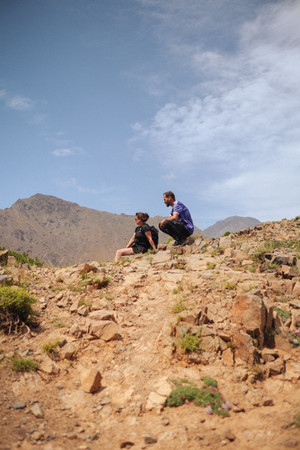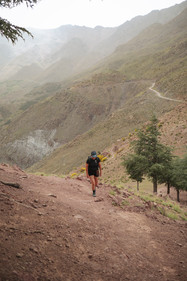Hiking in Imlil, Morocco: 3 day hikes in the Atlas Mountains
- Marjolein

- Jun 14
- 5 min read
Some places stay with you, and Imlil is one of them. This mountain village in Morocco's High Atlas Mountains, at around 1,700 meters elevation and just 1.5 hours from Marrakech, has become a familiar and beloved place for us. Oscar and I have visited twice before: the first time for a two-day hike in the mountains, and the second to summit Jebel Toubkal, at 4,167 meters, the highest peak in North Africa.
Imlil is often called the "gateway to Toubkal," but it's much more than a launchpad for ambitious trekkers. You come for the mountains, but you stay for the peace, the hospitality, and the stories of the people who live there. So when I brought my mom to Morocco this summer, I knew we had to come back. This time, we did three beautiful day hikes, and I'm excited to share them with you in this blog.

What you should know about Imlil and its surrounding berber villagesWhat many people don’t know is that Imlil isn’t just one village. It’s actually a collection of smaller Berber villages scattered across the valley. Targa Imoula, Ashayn, Mzike, Arghen, Tagadirt, Aremd, and Imlil center are all part of what locals simply call "Imlil." Each village has its own charm and character: some are perched high with valley views, others lie quietly along the riverbanks surrounded by orchards.

Our favorite local guide in Imlil: Mostafa
Back in February 2025, when we climbed Toubkal, we were guided by Mostafa, a local guide who quickly became a true friend. You’ll read his name several times in this blog, because he joined us again on this trip and made it just as memorable. Mostafa does everything to make sure you have a great experience. He’s super flexible, knows the area like the back of his hand, and has years of guiding experience. Just as important: he’s simply a joy to be around.
Whether you're planning to summit Toubkal or prefer the quieter, lesser-known routes around Imlil, I can’t recommend Mostafa enough. My advice? Don’t book through a big company, contact him directly for a more personal experience. You can reach him at: Guideimlil617@gmail.com.

Where to stay in Imlil?
We stayed at Douar Samra, a cozy and atmospheric guesthouse in the village of Tamatert (part of the Imlil valley). It’s peaceful yet just a 10-minute walk from the center. Everything is built in traditional Berber style with clay, wood, and earthy tones. The rooms are warm and welcoming. Some lit by candlelight in the evening, and you can even stay in a treehouse tucked between apple and walnut trees. Around the house you’ll find a garden full of herbs and vegetables, and even a mini farm. Chickens, cats, and ‘Jules the Donkey’ (there since the very beginning) roam the property.
Day 1: Hiking through the Ceder forest and Imlil Valley
Our first hike started at the Imlil waterfall. Although the scenery is beautiful, it’s also very touristy, with crowds of day-trippers. We headed off toward our lunch spot, a quiet area untouched by mules and therefore mostly free of tourists. We enjoyed a cup of fresh mint tea and a delicious chicken tagine.

After lunch, we continued into a fragrant ceder forest. According to Mostafa, this is one of the most beautiful ways to explore the Imlil valley. We started in Tamtert, the last village in the valley, and followed a remote trail into the pine and juniper woods. Except for a few playful children, we didn’t see another soul. The contrast with our winter hike earlier that year was striking: back then, the entire valley was covered in snow. Now, the landscape was dotted with blooming jasmine. The scents and colors of spring made this hike extra special.
Day 2: Climbing Touadja Peak (2,600 m)
Day two brought a bigger challenge: climbing Touadja Peak at 2,600 meters. This lesser-known summit near Imlil rarely appears in guidebooks, but it’s absolutely worth the effort. The trail is demanding, especially for beginners, but requires no technical climbing experience. In total, the hike takes about 6 to 7 hours, starting at around 1,700 meters in the valley and climbing to 2,600 meters.

We left our guesthouse around 9 a.m. The trail began gently through the forest, but quickly became steep. The wind picked up as we ascended, and in some spots we had to shelter behind rocks to catch our breath and avoid the strongest gusts.
Halfway up, we reached Tizi n'Tamatert: a mountain pass with sweeping views of the green Imnan Valley. Here, we met another hiker for the first time that day. It was the perfect moment for a group photo before the final push to the summit.

At the top of Touadja, the sun broke through. The 360-degree views were stunning: mount Toubkal in the distance, the Agafay desert near Marrakech, and countless peaks all around. We felt proud.
After a short break, we began the descent, my least favorite part of any hike. But we were rewarded at the bottom with a tasty kefta tagine and views of the valley below.
Day 3: Ancient walnut trees and traditional Berber Villages
On day three, we took it easier. We started our final hike through the Imlil valley, a relaxed walk past several traditional Berber villages scattered across the hills. We passed through Targa Imoula, Ashayn, Mzike, Arghen, and Tagadirt. Each with its own charm and slow, timeless rhythm. The paths wound through farmlands, orchards, and the heart of these quiet communities.

We couldn’t resist picking a few ripe cherries, haha. Later, we reached a clearing with several ancient walnut trees. Mostafa explained that this used to be an important trading spot centuries ago, where merchants from Europe and the Sahara exchanged goods: walnuts for woven blankets, herbs for vegetables, fruit for grain. Imlil’s location made it a perfect meeting point. And in many ways, it still is. These days, it’s mostly trekkers who pass through rather than caravans.
The villages we visited rely largely on farming. According to Mostafa, about 60% of the local population works in agriculture. Growing walnuts, apples, cherries, corn, and vegetables, and raising sheep and cows. 20% now work in the tourism sector, which has grown significantly in recent years. The remaining 20% works in construction.
After a few hours of walking, we ended up back in Imlil center. Our three-day mini trek complete. No major summit today, but a special glimpse into everyday life in the valley. Back in the village, we picked up some ground meat, tomatoes, onions, and peppers from a local shop, then dropped them off for "Swhaya": the Moroccan word for barbecue. About 30 minutes later, our ingredients came back perfectly grilled. We shared one last pot of mint tea and a relaxed lunch together, followed by a round of Cambion (a card game). Then, it was time to say goodbye to Mostafa and to Imlil. A warm ending to three incredible days in the mountains.


























































Comments